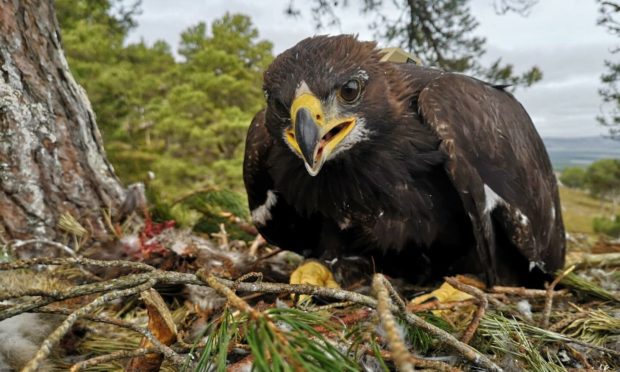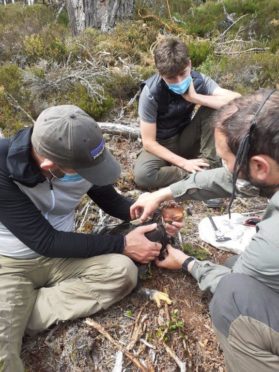Three golden eagle chicks have been tagged using the latest innovative technology to give an insight into their lives at the Cairngorms National Park.
Chicks at three estates, including two in Strathspey, have been tagged with Celltrack tags from the US which are among the “leading technology in raptor tagging”.
They will provide a “multitude” of data through daily transmissions so the birds’ movements, habitat preferences and mortality can be tracked in real-time.
The tagging is part of a partnership project developed and funded by the Cairngorms National Park Authority (CNPA) and NatureScot.
‘Previously unimaginable’
CNPA staff and partners aim to gain a better understanding of the lives of juvenile golden eagles through the hybrid Celltrack system, which has the added security of satellite communications when the birds are out of signal.
An inbuilt alarm system has been included should mortality occur, whether through natural causes, persecution or other anthropogenic influences. The tags can also detect unusual behaviour and send alerts with accurate locations.
Dr Ewan Weston, an independent research ecologist, has been responsible for tagging the chicks under licence, which has been granted on behalf of NatureScot by the British Trust for Ornithology (BTO).
He said: “Having been involved in fitting tags to eagles for 14 years, the technological advances in the tags we use now bring data that was previously unimaginable.
“The data we receive, feeds into wider research on the species and covers aspects of golden eagle biology and environment, providing an insight into aspects of their lives in incredible detail.
“This work has included aspects of their dispersal behaviour, interaction with the landscape and developments such as wind farms.”
‘Incredibly beneficial’
The CNPA first set out plans for a golden eagle tagging project in the Cairngorms National Park in 2019, but the impact of the pandemic and technical issues caused delays.
Before the switch to Celltrack tags, the original plan involved the use of BTO-provided tags. The organisation will still receive data from the birds and will continue to work alongside the partners.
The Seafield and Strathspey Estates are a partner in the project while RSPB Scotland has had one of their young golden eagles included.
Will Anderson, chief executive of Seafield and Strathspey Estates, said: We are very proud of our raptor populations here and as a result we are involved in several tagging projects.
“We are particularly pleased to be partnering with the Park Authority in this initiative as the type and volume of data collected is likely to be incredibly beneficial to be able to plan for the future with the birds needs in mind.”
Fraser Cormack, Abernethy warden for RSPB Scotland, added: “With raptors still being persecuted in Scotland, the data that these tags provide could be crucial in helping to stop such crimes.
“Also, with this potentially being a new territory it will be great to see the chicks movements after fledgling and where it disperses to in the future.”
Looking to the future
There are hopes that the success of this tagging project could lead to the technology being deployed further afield.
Dr Pete Mayhew, director of nature and climate change at the CNPA, said: “The more we know about golden eagles in the Cairngorms National Park – from fledging through to acquiring their own territories – the better we can conserve and enhance their populations for the future.
“This is another excellent conservation partnership project involving government bodies and private estates who all wish to see a healthy future for our raptor species.”
Andy Turner, crime officer at NatureScot Wildlife, added: “NatureScot are providing strong support to the CNPA on this project.
“This innovative technological development will strengthen our understanding of golden eagle movements, aiding both research and hopefully acting as a deterrent to illegal persecution.
“The ability for instant alerts and complex motion data will provide welcome new insights into the movements of these special birds. If this is successful, I hope we can deploy this technology more widely.”

